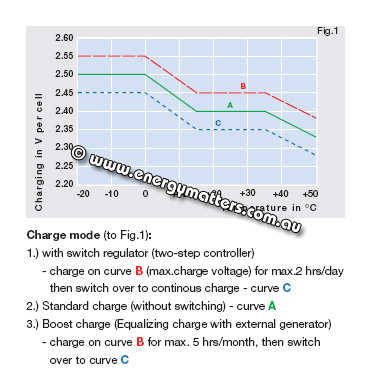I charge my
battery via the 240v hook up - the
battery never seems to get any charge from the alternator, which leads me to believe that there could be a problem with my van's charging system.
That really needs looking at before you invest further in any type of
battery - faults could result in you discharging the "leisure"
battery when parked up. Even fairly cheap digital test meters have a 10A DC measurement capability - if you take care about how you attach the leads to the existing connectors that would tell you if you have a charging and/or discharge problem.
Further, I think it may overcharge when connected to the mains.[...] When hooked up, the voltage on the LCD panel slowly builds (as one would expect) until 15.1v is reached, [...] I've been told this is too high, and it should cut off at 14.7v.
Here are the charging curves for the 130AH Sonnenschein gel (as originally fitted) per cell
So, for certain types of charging, at freezing point, 15V for the whole
battery would be OK. However - for normal conditions, yes, 15V is too much.
However, you say that you have now changed to an "ordinary" lead acid. Whilst flooded lead acids can, in general, take a higher voltage, again 15V is probably too much - without knowing the exact model and spec of what you're using I can't be specific, but around 14.5V would be more typical.
Yes, these half volts are critical.
There is a particular case in which you would take them to 15V and even higher, but that would be unlikely to be done in the van - it's really a work-bench procedure.
Very few motorhome chargers are going to have the complexity to recognise from the charging parameters exactly what sort of
battery is fitted, and so I think
Firefox is on the nail with the suggestion about using a good quality dedicated charger.
I'm also not convinced that the charger switches off, and may continue charging and making the
battery either overheat or gas the electolyte away. Can I test this?
Yes - the cheap digital multimeter will do that for you, and as a rough guide the van voltmeter or a traffic light type indicator will at lest tell you if the charger is still charging.
Since I've been using lead acid, they don't heat up, but I seem to be topping up electrolyte lost by gassing constantly.
That's part of the necessary chemical exchange - there are clever "hydrocaps" that return the water to the cells, but the important thing is that you are monitoring the levels and replacing as necessary.
Should I get 130Ah, as per the van's original spec? Would more/less power be an option?
You need to understand how much energy you are taking from your
battery and what your arrangements will be for replacing that. There are various on-line calculators that will assist you. If your charging capability is low then, bizarrely, you may be better off with a smaller capacity
battery - you might not be able to pull back a big
battery to a reasonable state of charge and it will start sulphating, but a small 110AH , regularly cycled to 100% SOC, will give better service. With regular access to a mains hook-up, possibly
solar panels and a sorted alternator system I'd say go as big as you can fit.
It's controversial, so I won't take a stance - but batteries in parallel can give problems - usually people fit them merely by running a pair of cables to the extra one, and I have seen this illustrated in several magazine articles. This will result in the new
battery getting a lower state of charge, and it may mess up your charging to some extent.
Probably, for ideal fitment, one should use "Y" leads, and of course the batteries should be matched in capacity and electrical characteristics.
Those of an experimental frame of mind could try measuring the potential across the extra link cables and working out what's happened to the power ...
Any further musings/wisdom would be much appreciated!
You asked for it!
Mild Red
